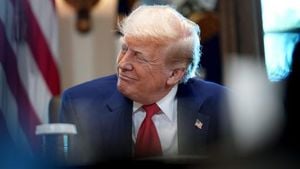On Wednesday, April 30, 2025, the United States and Ukraine reached a significant milestone by signing a deal that grants Washington access to Ukraine's vast critical minerals and natural resources. Dubbed the United States-Ukraine Reinvestment Fund, this agreement marks a pivotal moment in the ongoing partnership between the two nations as Ukraine continues to grapple with the ramifications of Russia's invasion.
Treasury Secretary Scott Bessent emphasized the importance of the agreement, stating, "This agreement signals clearly to Russia that the Trump administration is committed to a peace process centered on a free, sovereign, and prosperous Ukraine over the long term." He highlighted the collaboration as a demonstration of both nations' commitment to achieving lasting peace and prosperity.
The signing of this deal comes after months of negotiations, which had previously been derailed during a tense Oval Office meeting between President Donald Trump, Vice President JD Vance, and Ukrainian President Volodymyr Zelenskyy. During that meeting, Trump expressed frustration with Zelenskyy, claiming he lacked the necessary leverage to win the war against Russia.
Despite earlier tensions, Trump has recently softened his stance, criticizing Russian President Vladimir Putin for complicating negotiations with his aggressive military actions in Ukraine. In a statement following the signing, Trump noted, "In theory, this means that the U.S. will get more from Ukraine than it contributed. I wanted to be protected," emphasizing his desire for a return on investment for American taxpayers.
For Ukraine, this agreement is seen as a strategic move to secure continued U.S. military aid. Prime Minister Denys Shmyhal expressed optimism, stating, "This is truly an equal and good international deal on joint investment in the development and restoration of Ukraine between the governments of the United States and Ukraine." Ukraine's economy minister, Yulia Svyrydenko, who traveled to Washington to finalize the deal, echoed this sentiment, highlighting the potential for attracting global investment.
Initially, there were doubts about the readiness of the agreement, as Bessent indicated that last-minute changes were being made by Ukrainian officials. However, both sides managed to finalize the deal, which is expected to last for ten years and establish a framework for joint investment in Ukraine's critical mineral extraction.
The U.S. has been actively seeking access to over 20 raw materials deemed strategically critical, including titanium, uranium, lithium, and graphite. These resources are essential for various industries, including aerospace and electric vehicle manufacturing. The deal stipulates that 50% of future revenues from Ukrainian mineral licenses will be directed to the investment fund.
Importantly, the agreement allows Ukraine to maintain ownership over its subsoil and resources, with the Ukrainian state determining what and where to extract. This provision addresses earlier concerns that the U.S. might gain disproportionate control over Ukraine's natural resources.
The backdrop of this agreement is the ongoing conflict in Ukraine, where Russian forces have captured nearly a fifth of the country's territory since the invasion began in February 2022. The United Nations has reported a significant rise in civilian casualties, with 2,641 verified casualties in the first three months of 2025 alone—nearly 900 more than during the same period last year.
As the war continues, the U.S. has been pushing for a ceasefire, with Secretary of State Marco Rubio emphasizing the need for concrete proposals from both sides to end the conflict. However, Russia has rejected proposals for an immediate ceasefire, complicating the situation further.
In light of these developments, the U.S. State Department has signaled that it may withdraw from negotiations if progress is not made. This urgency underscores the critical nature of the newly signed deal, which aims to provide a foundation for Ukraine's post-war economic recovery while ensuring that U.S. interests are safeguarded.
While the agreement is a step forward, it remains to be seen how effectively it can be implemented amid the ongoing hostilities. Both Ukraine and the U.S. are hopeful that this partnership will not only facilitate economic growth but also bolster Ukraine's defense capabilities against further Russian aggression.
As the situation evolves, the international community is watching closely, hoping that this agreement can pave the way for a more stable and secure future for Ukraine.






